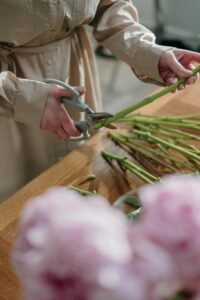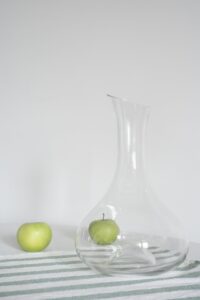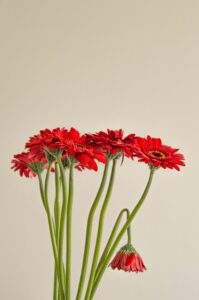Prolong vase life of cut flowers wishes of every person because their ephemeral beauty often leaves us wishing for more time to savor their presence. Prolonging the vase life of cut flowers is an art that combines thoughtful care, strategic practices, and a touch of floral finesse.
Cut flowers, with their delicate petals and vibrant hues, bring a touch of nature’s elegance into our homes. Cut flowers, whether sourced from the garden or a florist, offer a fleeting glimpse of nature’s wonders. Their journey from bloom to vase is a celebration of color, fragrance, and the ever-changing dance of life. Yet, as they grace our living spaces, the desire to extend their freshness becomes a natural inclination, prompting us to explore ways to nurture and preserve their charm.

Several factors challenge the longevity of cut flowers. Bacterial growth in the vase water, ethylene gas produced by ripening fruits, and natural aging processes can hasten wilting and diminish the vibrancy of petals. Successfully navigating these challenges requires a blend of scientific understanding, attentive care, and practical techniques. Prolonging the vase life of cut flowers is a harmonious blend of science, care, and a keen appreciation for the ephemeral beauty they bring.
Harvesting Time for Cut Flowers
The optimal time for harvesting cut flowers is early in the morning or late in the afternoon. During these times, the temperature is cooler, and the flowers are well-hydrated, having absorbed water overnight or throughout the day. Choose days with mild temperatures for harvesting. Hot weather can cause stress to the flowers, leading to faster wilting. Harvesting during cooler conditions helps preserve the flowers’ freshness. Try to avoid harvesting flowers in the full sun, especially during the peak of the day. Harvesting in the morning or late afternoon helps reduce stress on the plants and minimizes water loss.

Harvesting Stage of Cut Flowers
Different flowers have specific stages of development when they are best for cutting. Familiarize yourself with the ideal harvest time for each type of flower in your garden or arrangement. For example:
Roses: Harvest when buds are just starting to open.
Zinnias: Harvest when fully open.
Lilies: Harvest when the first bloom has opened.
For bulb flowers like tulips or daffodils, harvest them in the bud stage. This ensures that they will continue to open and bloom once arranged in a vase.

Harvest flowers at their peak maturity. Avoid harvesting too early or too late, as this can impact the longevity of the blooms. Each flower type will have visual cues indicating its optimal harvest stage. Harvest flowers when they are well-hydrated. The turgidity of the stems and petals is a good indicator of hydration. Flowers harvested when well-hydrated tend to have a longer vase life.
Use a Water Bucket: After harvesting, immediately place the cut flowers in a water-filled bucket. This prevents air from entering the stems and promotes water uptake, enhancing their freshness.
Cut Flower Stem Cutting Technique to Prolong Vase Life of Cut flowers
Trimming cut flowers properly before placing them in a vase is a crucial step to enhance water uptake, extend vase life, and ensure a stunning floral arrangement. Choose sharp scissors or pruning shears. Dull tools can crush stems, making it harder for the flowers to take up water. Inspect the cut flowers for any damaged or decaying foliage. Remove any leaves that would fall below the waterline in the vase to prevent bacterial contamination.

Using sharp scissors or pruning shears, trim the stems at a 45-degree angle. Cutting at an angle increases the surface area for water absorption, allowing the flowers to take up more water. Remove any leaves or stems that will be submerged in the water. Submerged foliage can decompose and create a breeding ground for bacteria. To prevent air bubbles from entering the stem, cut the flowers underwater or under running water. This ensures that the stem can immediately draw in water without obstruction.

Healthy, well-trimmed stems improve the overall appearance and vitality of the arrangement. Trim the stems to the desired length based on the height of your vase. For a more natural look, vary the stem lengths rather than cutting them all at the same level. Once trimmed, immediately place the cut flowers in the prepared vase. Delaying the placement can lead to air entering the stem, hindering water uptake.
Use Clean Vase to Prolong Vase Life of Cut flowers
The longevity of cut flowers greatly depends on the care they receive from the moment they are harvested until they adorn a vase. Florists, with their expertise, employ several practices to ensure the flowers remain fresh and vibrant for an extended period. Starting with a clean vase is a crucial first step in their meticulous process.

A clean vase is essential for preventing the growth of harmful bacteria in the water. Bacteria can clog the flower stems, obstructing water uptake and leading to premature wilting. Residue from previous arrangements or deposits in the vase can contaminate the water, negatively affecting the flowers’ overall health. A thorough cleaning helps eliminate any potential contaminants. Flowers absorb water through their stems, and any impurities in the water can hinder this process. A clean vase ensures that the water remains pure, providing the flowers with a healthy hydration source.
Use Vase Solutions to Prolong Vase Life of Cut flowers
Preparing a proper vase solution is crucial for extending the vase life of flowers by providing essential nutrients, preventing bacterial growth, and maintaining optimal conditions for hydration.
Fill the vase with fresh, clean water. The water should be at room temperature or slightly lukewarm. Avoid using hot or cold water, as extreme temperatures can stress the flowers.

Change the vase water every 2-3 days, even if it still looks clear. Fresh water helps prevent the buildup of bacteria and keeps the flowers hydrated.
If you have a floral preservative, follow the instructions on the package to add the appropriate amount to the water. Floral preservatives typically contain nutrients to nourish the flowers and antimicrobial agents to inhibit bacterial growth. If you don’t have a commercial preservative, you can make a homemade version if you don’t have a commercial floral preservative, you can make a simple homemade version using common household ingredients:
Mix the following in the vase water:
2 tablespoons of sugar (provides nutrients)
2 tablespoons of lemon or lime juice (maintains acidity and prevents bacterial growth)
1/2 teaspoon of bleach (inhibits bacterial growth)
Adjust the quantities based on the size of your vase. Always follow proper measurements to avoid overfeeding the flowers.

Change Water Daily to Prolong Vase Life of Cut flowers
Changing the vase water daily is a simple yet effective practice to prolong vase life of cut flowers. This routine ensures a clean and nutrient-rich environment for your blooms, promoting optimal hydration and inhibiting the growth of harmful microorganisms.
As flowers are cut, bacteria can quickly multiply in the vase water. These microorganisms clog the stems, impeding water uptake and accelerating the wilting process. Daily water changes help eliminate existing bacteria and prevent new growth, maintaining a pristine environment for the flowers. Freshwater provides a continuous supply of nutrients to the cut flowers. Regular water changes ensure a consistent influx of nourishment, supporting the blooms’ vitality and extending their overall freshness.

By minimizing bacterial contamination and providing a consistently clean water supply, daily water changes contribute to the overall health and longevity of cut flowers. This, in turn, allows you to enjoy the beauty of your floral arrangement for an extended period.
Recut Flower Stem
If flowers start to wilt, recut the stems at an angle underwater to prolong vase life of cut flowers. This helps eliminate air bubbles that may have entered the stem, allowing for better water uptake. If the stems have become slimy or discolored, consider trimming them slightly at an angle before placing the flowers back into the freshwater. This allows for better water absorption. Gently arrange the flowers back in the vase, ensuring that all stems are submerged in clean water.

Remove Wilted Flowers to Prolong the Vase Life of Cut Flowers
To extend the vase life of cut flowers, the removal of wilted or spent blooms is a crucial practice. Wilted flowers release ethylene gas, a natural plant hormone that accelerates the aging process of nearby blooms. By promptly removing wilting flowers, you minimize the concentration of ethylene in the vase, slowing down the deterioration of the remaining blossoms. Regularly removing spent blooms ensures that your floral display remains visually appealing.

Protect Cut Flowers from Ethylene Gas to Prolong Vase Life of Cut flowers
Ethylene gas is a natural plant hormone that can accelerate the aging process of cut flowers, leading to a shorter vase life. To prolong the beauty of your floral arrangements, it’s essential to take measures to avoid exposure to ethylene gas. Ethylene is produced by ripening fruits and vegetables. Avoid placing your cut flowers near fruit bowls or areas where fruits are ripening.

Provide good ventilation by opening windows to allow ethylene to dissipate. Fresh air circulation can help reduce the concentration of ethylene around your cut flowers. Keep cut flowers away from direct sunlight and heat sources. Elevated temperatures can exacerbate the effects of ethylene gas.

The prolonged vase life of cut flowers gives a visual appeal for an extended period. This allows individuals to enjoy the vibrant colors, intricate shapes, and overall beauty of the blooms for as long as possible.


